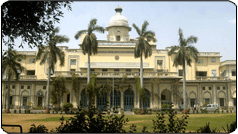Chhatar Manzil | Farhat Bakhsh Palace
Farhat Bakhsh is better known today as Chhatar Manzil for the structure annexed to it later. Farhat Bakhsh was originally constructed by the French general, Claude Martin as his 'town house' (as he called it) after clearing the woods on the bank of the river Gomti. close to the Residency. It was completed in 1781 and Martin lived in it, till he died in one of its rooms in 1800. However, according to his Will, he was buried at Constantia (which is now the La Martiniere College for boys) where he had provided an underground vault for the purpose.
The multi-storeyed house of General Martin was a peculiar building. It had two storeys below the ground level which were visible only when the river was at its lowest level. These basements had large rooms and as the river rose in the monsoon, they were flooded and had to be vacated, only to be re-occupied when the water level descended. The basements were connected to two octagonal towers on the sides which provided a draught of air for cooling and ventilation. Above the basement, on the ground floor, there was a large hall that was partly extended over the river on the north. It was supported on piers placed in the river and rested on arches. The house also had airy pavilions on the top. It had two telescopes installed on the roof for astronomical observations that were brought from England. Eventhough General Martin was not married, he had a separate zenana for his mistresses which was built on one side of the building along with a garden.
In May 1781, while the house was nearing completion, some members of the fleeing troops of Raja Chet Singh of Banaras also attacked the house of Claude Martin who repulsed the attack by placing two small guns at his door. But the incident goaded Martin to fortify his house. He dug a moat on three sides of the house (the fourth side being on the river itself) and provided a lofty arched gateway with a draw-bridge, as the entrance.
The halls of the house served as a library and a museum of sorts for Martin. He had a collection of nearly 4000 books in French and English, besides 500 hand written volumes in Persian. His collection referred to as a 'perfect Museum' full of 'infinite amusements' by an English visitor had large mirrors, china and glassware, a room full of fireworks, Chinese toys, biological specimens (even a female skeleton), puppet theatre accessories, watches, technological innovations of his time such as steam engines, printing presses and magic lanterns (glass slide projector).
Governor General Shore's remark after he visited the place in 1797, that it would take nearly a week to examine them (items in the collection), gives an idea of the enormous collection. He also had a large collection of paintings.
After the death of Claude Martin, the place was auctioned and bought by his Spanish agent, Joseph Queiros for rupees forty thousand, where he outbidded the reigning Nawab of Awadh, Saadat Ali Khan. The Nawab later took the building for a change of air during an extended illness. On recovery he exerted pressure on Queiros to sell the building to him. After the purchase he named it Farhat Bakhsh (bestower of happiness).
The building served as a residential palace for the Nawabs and Kings of Awadh till Wajid Ali Shah (1847-1856) shifted his residence to Qaiser Bagh, (when it was built by him). As such, it was also called Qasr-e-Sultan, the palace of the King.
Nawab Saadat Ali Khan added the Lai Baradari, as a court, and a market Cheena Bazaar in proximity of Farhat Bakhsh. His son Ghazi-ud-Din Haider, crowned the first King of Awadh, laid a garden lined with statues near Farhat Bakhsh and called it Gulistan-e-lram, (the garden of paradise). He also built a Kothi named Darshan Bilas opposite the garden.
Chhatar Manzil emerged from the modifications and additions made by Ghazi-ud-Din Haider in Farhat Bakhsh [but this annexe was incomplete till his death in 1827]. His son Naseer-ud-Din Haider, the second King completed it. He also built another similar but smaller structure [which was called Chhoti (smaller) Chhatar Manzil while the earlier one came to be referred to as Bari (larger) Chhatar Manzil]. They were known as such for the golden umbrellas, Chhatar, placed atop their domes.
Except for the two Chhatar Manzil structures and some part of Lai Baradari, the major portion of the Farhat Bakhsh complex was destroyed, along with adjoining buildings of Qaiser Bagh, by the British after they succeeded in crushing the rebellion in Awadh in 1858. The larger Chhatar Manzii served as an exclusive Club for the English.
After Independence, Farhat Bakhsh and Chhatar Manzii were handed over to the Council of Scientific and Industrial Research which used it for housing the Central Drug Research Institute (C.D.R.I.).
The smaller Chhatar Manzii that housed a State government office suddenly collapsed in the recent 60s (after 1960), but luckily nobody was hurt because the collapse occurred on a non-working day.
Source:
Hindustan Times, City Scan, A Time in History
Wednesday 6.8.1997 — Chhatar Manzil-Claude Martin's French legacy

